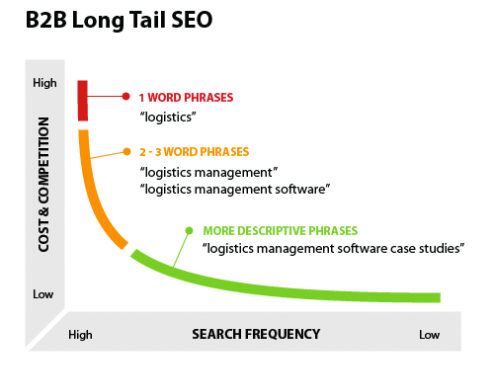Garnering some “industry insight” is essential to do up front as this is pivotal to the success of your SEO strategy. From the very beginning we need to know what it is you do, what you hope to rank for, and importantly: why.
From this we can determine how you are performing, how your competitors are performing (if you have any), and what it takes for you to climb the rankings and stay there. We will need to hear from you what content you have, and are willing to have, both on your home page and across your website. This is probably the part of the process where the client is most involved and where we can determine both short- and long-term goals for your business. If we get this wrong, there is not much point measuring your growth further down the line as it would mean we have been aiming at the wrong objectives from day one. Which is a good time to say: if your strategy changes midway then we need to start your content strategy all over again.
It is probably a good time for an example…
Let’s say you are trying to rank for “B&B Knysna” – and that is, simply put, what service you offer and advertise on your website. A place to stay in Knysna, that happens to be a B&B. We would suggest your home page reflects that but perhaps (and it is quite likely) all your competitors are vying for this same keyword, and are easily outranking you, and it doesn’t look likely that you would rank there within six months. At this point it might make sense to look at the data and realise there are actually thousands of terms people search for that your business would be a good search match for.
Some ideas:
- cheap accommodation Knysna
- place to stay in Knysna
- hotel Knysna
- holiday accommodation Knysna
- weekend break in Knysna
- fancy bed and breakfast near Knysna
The list obviously goes on and on – interestingly, beyond the most common 20-30% of keywords searched by online users we get into what is called the “long tail”, more on that later – and so we have much that we can target. This is really good news for anyone starting out in SEO as it means “the pie” is pretty big and everyone gets a bit of it.
What we would want to do is focus in on the main search terms, and have your site reflect those terms. With a good home page targeting the main search term, other pages targeting the next best 4-5 terms, and then blog posts covering the rest. It is slightly more work than it seems, and does mean you have to quite literally look at your competitors websites and see what they are trying to rank for; thankfully this is quite easy to do by inspecting them using a free online tool.
At the end of the day, once we have heard all about your business, and looked at the search data, we can propose a bouquet of keywords and search terms for you to target and rank for. You want to start small and try rank for 4-5 terms, and as more traffic comes (and ideally sales with it) you then have the budget to try and rank for another five terms, then another, and so it goes. Without content, it is very hard to rank, so you just need a long-term plan for pushing content out. Once you have covered the non-competitive keywords and between you and the competition have “gobbled up” all the 20-30% main terms searched for, you then want to go after the long-tail keywords.
Here is a lovely visual, courtesy of Search Engine Land, to show you why the term “long-tail” exists. It’s simply one of those mathematical things where as you move right there are fewer searches, and therefore it’s unlikely someone will have tried to rank for it on their website. The visual should be quite self-explanatory…

So, to summarise, you want to go for a few well-researched keywords upfront, then over time build out a whole host of long-tail keyword targeted content. Whether it is in the form of news articles, or blog posts, or well crafted web pages is irrelevant – to Google they are all just pages of HTML with content on them – mainly you need to have long articles, of good quality, that answer questions that users search for; it’s worthwhile saying now, in case it hasnt been said before: in a nutshell, Google matches user’s searches to results. If your website has the “answers” to that search you will get traffic; it is as simple as that.
A final note is on Google Ads. Perhaps you don’t have the time or desire to produce content or to try rank using SEO – then Google Ads is for you. Added to that, it is then very easy to know what to attempt to advertise for in Google Ads, as you have done the keyword research. Or, even better, include Google Ads data in your keyword research. By which I mean: Google Ads (the platform, when you use it) gives you live feedback on how much it will cost you to have a term rank on the first page, and therefore if it is competitive.
My bonus/master tip: Should you choose to dovetail your SEO strategy with an Google Ads campaign – which I highly advise – bounce between the two, learning from the one and applying it to the other. For example, if a Google Ads keyword is expensive (let’s say R25 a click) rather invest money into ranking for that term organically via good SEO practice. Conversely, if it will take you one year to rank organically for a term using SEO and you need traffic and sales within weeks, then pay the money, make the sacrifice, and advertise with Google Ads. Lastly, if you have the budget: do both! You may wait a year, but then once you do rank, it is very rare to drop from the rankings if you have gone about everything correctly.
